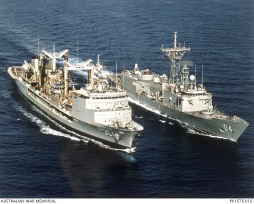On 2 August 1990 Iraq invaded its rival oil-exporting neighbour Kuwait. The invasion was widely condemned, and four days later the United Nations (UN) Security Council unanimously approved a trade embargo against Iraq. A blockade of Iraq’s access to the sea followed within weeks, as the United States assembled a large multinational task force in the Persian Gulf, while another was formed in Saudi Arabia.
By the end of 1990 the coalition force numbered some 40,000 troops from 30 countries, although the United States remained the dominant partner in the coalition. In November 1990 the UN Security Council set 15 January 1991 as the deadline for an Iraqi withdrawal from Kuwait. Iraq failed to comply, and on 17 January full-scale war erupted when coalition forces began an air bombardment of Iraqi targets. Within four days, coalition forces destroyed the Iraqi invading forces and drove the remnants out of Kuwait, although the Iraqis retained significant military strength intact in Iraq. The air bombardment continued without respite until the war ended 43 days later.
On 24 February 1991, after more than a month of air attacks, the coalition’s ground forces moved against Iraqi positions in Kuwait and in Iraq itself. The magnitude and decisiveness of these strikes destroyed what was left of Iraq’s capacity to resist. After two days of air strikes, Baghdad radio announced that Iraq’s armed forces had been ordered to withdraw from Kuwait to the positions they had occupied before August 1990.

Gulf of Oman: an Iraqi motor vessel is intercepted by HMAS Darwin
Australia was one of the first nations to join the coalition force. Australian forces were deployed under the auspices of the UN. Three Australian warships conducted blockade operations in the Persian Gulf. Australia also provided a supply vessel, four medical teams and a mine clearance diving team that joined a protective screen, under US operational control, around aircraft-carrier battle groups in the Gulf.
The Royal Australian Navy (RAN) provided vessels for the multinational naval force, which formed an interception force in the Persian Gulf to enforce the UN sanctions. The RAN presence included two frigates and the replenishment ship HMAS Success, which, having no air defences of its own, relied on the army’s 16th Air Defence Regiment. In January 1991 the replenishment tanker HMAS Westralia left Fremantle, Western Australia, to relieve Success. Four warships, HMAS Sydney (IV), HMAS Adelaide, HMAS Brisbane, and HMAS Darwin, also served tours of duty in the Persian Gulf. During the operational phase of their deployment, they formed part of the anti-aircraft screen for the carrier battle groups of the US Navy. An RAN clearance diving team was also despatched for explosive ordnance and demolition tasks.
In addition to naval units, Australian personnel took part on attachment to various British and American ground formations. A small group of RAAF photo-interpreters was based in Saudi Arabia, together with a detachment from the Defence Intelligence Organisation. Four medical teams were also despatched at the request of the United States. Although the ships and their crews were in danger from mines and possible air attack, Australia’s war was relatively uneventful and there were no casualties.
At the conclusion of hostilities, 75 Australian personnel were sent to northern Iraq to assist in the provision of humanitarian aid to Kurds living in the UN-declared exclusion zone, while ships of the RAN remained on station, at the request of the United States, to enforce UN sanctions. Several Australian naval officers commanded the multinational interception force. Australia later provided weapons inspectors in Iraq to monitor the discovery and disposal of prohibited nuclear, chemical and biological “weapons of mass destruction”.

Gulf of Oman: HMAS Darwin (04) is replenished by HMAS Success (304). C226497
References:
J. Bickerton, 43 days: the Gulf War, Melbourne, Text Publishing and the Australian Broadcasting Corporation, 1991
Peter Dennis, et al., The Oxford companion to Australian military history, Melbourne, Oxford University Press, 2nd edition, 2008
David Horner, The Gulf commitment: the Australian Defence Force’s first war, Melbourne: Melbourne University Press, 1991
David Horner, Australia and the “New World Order”: from peacekeeping to peace enforcement 1988–1991, Melbourne: Cambridge University Press, 2011
John Mortimer and David Stevens (eds), Presence, power projection and sea control: the RAN in the Gulf, 1990–2009, Canberra, Seapower Centre – Australia, 2009
Source: https://www.awm.gov.au/articles/event/gulf (accessed 19 July 2019)